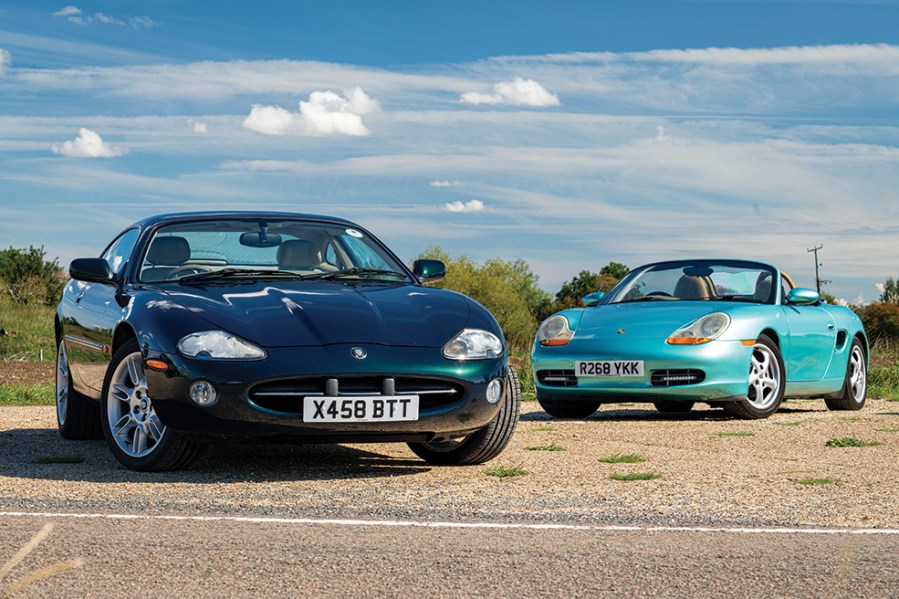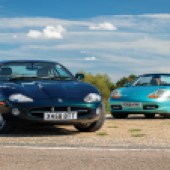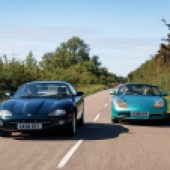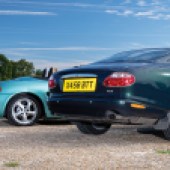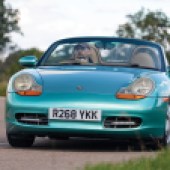While not exactly rivals in period, the Jaguar XK8 and Porsche Boxster can each be had for around the same price today. We take to the road to see which is best
Words: Aaron McKay
These two are very different cars. The Jaguar is very much a GT while the Boxster is a much sportier proposition. There’s a 4.0-litre V8 against a 2.5-litre flat-six, and while the power-to-weight ratio is similar, pushing the throttle in each is a very different experience. Most obviously, the Jaguar is also much bigger than the Boxster – there’s 400kg of weight and 400mm of length between them. On paper, they shouldn’t really be rivals.
Today, however, each of these cars can be found at around the same price. The £48,000 Jaguar XK8 of 1996 has joined the £34,000 Porsche Boxster 2.5 at the point in the market where as little as £5000 will buy one of these 1990s icons. Each ticks a lot of the boxes that today’s modern classic enthusiast will want checked off: distinctive, clever and elegant design with more than a dash of glamour, an exotic engine with more than four cylinders, strong performance supported by rave reviews of contemporary road testers, and the kind of marque-reviving history that should secure it as a future investment.
The XK8 was unveiled at the 1996 Geneva Motor Show in a display evocative of the E-type’s debut 35 years before. Design was by Fergus Pollock (under Geoff Lawson) and was, like the XJ two years prior, decidedly retro. Unlike the XJ-S before it, the XK8 very deliberately drew its inspiration from the E-type; not just in its overall slinky shape, but in key details like the oval front grille and rounded sides with tucked in wheels. It was all neatly packaged with integrated bumpers, bespoke curved lights, and an elegant roofline that matched up with a sizeable boot.
Inside, the XK8 enjoyed the first of a new generation of interiors from Jaguar, most readily identified by dials inset into a long so-called ‘Spitfire wing’ of walnut wood trim. One-piece sports seats subtly echoed this styling feature and were also right up to date with the fashion of the 1990s. It was nonetheless all unmistakably Jaguar, with the famous U-gate gearbox shifter centred on a hefty transmission tunnel that rounded up to a centre stack. The XK8 was initially available in two trim levels, Sport and Classic. Sport is rare; with fabric seats, it was likely a marketing directive from owners Ford to lure in less traditional buyers.
The XK8 received some detail changes for the 2000 model year, including a subtly different front bumper with new, larger driving lamps, new taillights, and two-piece seats. The proper facelift came in 2003 however, when new Xenon headlamps, wheels and slightly different badging were added along with some new interior options including an Aluminium Pack which replaced the traditional walnut trim.

The storm of press coverage was almost as wild for the new Porsche on the run up to its release in 1996. It was the first all-new car for the company since the 924 and was recognised to be a preview of what was to come for the new 911. It began with Porsche chairman tasking Harm Lagaay’s design team with making a small sports car concept to display at the 1993 Detroit motor show; from a sketch by American designer Grant Larson, the result stunned the audiences at the show.
Many have since criticised the production car for diluting and corrupting the lines of that original show car, but it’s worth noting that Larson himself was charged with marrying that original sketch with production reality, incorporating safety, cooling, and even suspension space requirements. It has aged well, like the Jaguar, offering clean lines without many corrupting details, and echoes just enough of the past while being 1990s in a very good way.
Inside, more criticism of its divergence from the concept will pop up but it is still a pleasant design. Bold Porsche dials with the classic centred tachometer dominated the dashboard which is flat and colour-coded plastic – unless you opted for the extended leather option – while the seats were the classic Porsche one-piece bucket design from the 911.
The Boxster was facelifted in 2002, with new bumpers and clear-lens lights. The alloy wheel range was also updated, but the most important changes were inside where lots of the criticisms of early models were addressed: the plastic rear window as replaced by a heated glass one, there was finally a glovebox not just the optional centre stack for storage, and the steering wheel was updated to a much more modern looking design.

Jaguar XK8 vs Porsche Boxster: on the road
The XK8 feels just as special to drive as it looks, and that brand of special is Jaguar. It is beautifully serene from the moment you lift off the finely judged brake pedal and let it just glide forward. The engine and gearbox are very smooth, the steering light and outside noises almost completely shut out. It all feels so effortless and relaxed that it really does bring your heartrate down a notch. Lean on the throttle a little to make the dials move and the car feels even more content at speed.
The XK8 was also the debut of a new engine for Jaguar, the XJV8. At first a project to develop three engines – a V6, V8, and V12 – it was codenamed XJ26 (as sum of the three cylinder counts), but Ford’s re-evaluation in the early 1990s promoted just the V8 though the V6 would be developed later. The AJV8 eventually replaced the AJ6 in the XJ saloon car in 1997. It was quite an advanced engine for the time, featuring variable cam timing, aluminium alloy construction, and a clever cooling system that diverted 50 per cent of the coolant directly to the head, warming the engine up in just four minutes. Cosworth also designed the head, and with a 10.5:1 compression ratio it produced 290bhp and 290lb ft of torque. The supercharged version in the XKR was uprated and produced 370bhp.
In 2003 the AJV8 was enlarged to a 4.2-litre by increasing the stroke for a 200cc increase in capacity, but by clever reworking of the crankpin journals meant that it was physically no taller in the engine bay. Most enthusiasts prefer this engine as it produces more power and torque – at 300bhp and 310lb ft – and has a better record for reliability. Also at this time the ZF gearbox was updated from a five-speed unit to a six-speed.
The suspension uses double wishbones all round and is softly sprung on the XK8, although there was available an R-performance package from 2003 that uprated various components to make it handle as sharply as the more aggressive XKR. To many, this package is worth searching out. But to others, the wonderful pliancy of the standard XK8 makes it a fantastically comfortable long-distance cruiser. For both, it might be worth considering a car with the optional Computer Active Technology Suspension (or CATS for short), which employs adaptive dampers which change from firm to soft depending on driving behaviour.
The XK8 handles surprisingly well for a heavy car. The turn-in is sharp, often deceptively so on its highly assisted and quick steering rack, and there’s plenty of power to see you through the corner. It can be a bit difficult to place the car accurately, and it certainly feels most at home on larger roads rather than narrow b-roads. The roof feels quite small and you can sense that most of the car is beneath the rather narrow window line. This becomes a bit of a worry when manoeuvring at low speeds too because it is difficult to judge the car’s dimensions which slope away mysteriously from your line of sight.

The Porsche’s lines, on the other hand, are immediately familiar to the driver even if he’s been introduced into the driver’s seat blindfolded. You can see each corner and there is the sense that you’re sitting directly in the middle of the car, so that placing the Boxster anywhere on the road feels intuitive and easy. The engine is as smooth but noisier than the Jaguar’s, with a distinctive clatter of a boxer even if it is now water-cooled as opposed to the older air-cooled Porsches. The controls share a similarly high quality damped, solid feeling to the Jaguar, but once at speed they pick up a sharpness and directness that puts the Boxster into a different category – no surprise there.
The flat-six sitting directly behind the driver but ahead of the rear axle was all new for Porsche. The only similarity it shares with its air-cooled predecessor are the same 118mm bore centres. The rest is completely different. It’s a dry-sumped, 24-valve aluminium engine with water cooling and debuted in the Boxster in 2.5-litre form, before going to 2.7 litres in 2000, with a 3.2-litre version also available in 2000 in the Boxster S. The 2.5-litre made 204bhp and 181lb.ft of torque, and while it does feature variable intake timing that provides 147lb.ft between 1750rpm and 4500rpm, it simply doesn’t have the effortless shove of the Jaguar’s V8, even with 400kg less to move.
But like the Jaguar’s V8, it rewards the driver for holding onto the gears to the top end of the rev range. The boxer six comes noticeably on cam at about 4000rpm and holds an intoxicating engine note that soars up to 7000rpm with addictive drama. It’s best manipulated by a slick-shifting five-speed manual but the optional automatic is far from disappointing, thanks to five well-chosen ratios and the option for manual, Tiptronic control. The Jaguar will be right alongside, with a deeper, bassier note but is generally much more subdued and measured than the Porsche.
Surprisingly it’s the Porsche that does without double wishbones for suspension, as packaging and cost restraints led the design and engineering teams to the MacPherson strut. Still, there’s plenty of exotic componentry underneath the Boxster, including generous use of aluminium and even aerodynamically profiled lower suspension arms that direct air to the front brakes. The brakes themselves are monobloc items derived from the GT1 racer, and put even the Jaguar’s hefty items to shame.
The Porsche naturally lives for twisting, challenging roads, and is narrow and weildy enough to be a real joy on a British B-road. While it doesn’t quite match the Jaguar’s degree of refinement, especially in noise insulation, it remains a comfortable option for travelling long distance. Its seats aren’t as soft but are well contoured and supportive, and the driving position is good with plenty of adjustment. Where the Jaguar really beats the Boxster, though, is in the interior design, perceived quality, and its exceptionally supple ride quality.

Jaguar XK8 vs Porsche Boxster: our verdict
£5000 isn’t much money at all for cars like these. That you can even begin to afford one of these cars for that seems preposterous, and most non-car people won’t believe it, but that’s the great thing about the modern classic car market. You will have to settle for an early example of each, since the later cars have always tended to be the more desirable for their extra power and equipment. But both the XK8 4.0 and Boxster 2.5 are truly superb cars that will not leave their owners wanting.
Unsurprisingly the Jaguar takes the crown for grand-touring, while the Boxster beats it when darting from left to right is the task at hand, but each provides more than enough talent on each of its weaker side to impress in their own right. The reality is that many owners will come to discover these talents after they buy one, and that the buying decision will be down to less tangible things like the looks and the history.
Even in the striking hue of Ocean Jade, the Boxster does live in the shadow of the XK8 and not just because of the Jaguar’s sheer size. You just don’t seem to notice anything but the elegant shape of the XK8. You would find yourself planning trips to the Riviera just so you can look at it with the Mediterranean in the background. The Porsche is attractive but more subtle, and so is its history. Both cars are landmarks for each maker, but it’s the Jaguar that’s still the car of the moment.
No wonder then that values have been on the rise for some years already, while the Boxster remains at an all-time low. Each is a bargain but it’s the Jaguar for us.

